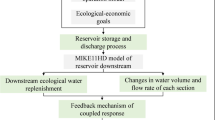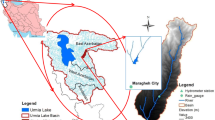Abstract
In this paper, a new systematic approach is designed to maximize the demand coverage and receiving waste load by river–reservoir systems while enhancing water quality criteria. The approach intends to control the reservoir eutrophication while developing a trade-off between the maximum receiving load and shortage on demand coverage. To simulate the system, a hybrid process-based and data-driven model is tailored. Initially, the two-dimensional hydrodynamics and water quality simulation model (CE-QUAL-W2) is linked with an effective single and/or multiple optimization algorithms (PSO) to evaluate the proposed scenarios. To increase the computational efficiencies, the simulation model is substituted with a surrogate model (ANN) in an adaptive-dynamically refined routine. The proposed method is illustrated by a case study in Iran, namely, Karkheh River Reservoir, for 180-monthly periods. The results showed the applicability of the methodology especially to solve high-dimensional multi-period complex water resource optimization problems. Also, the results demonstrated that eutrophication could be reduced under the optimal inflow phosphate control and reservoir operation, regulating the total phosphorous concentration in the reservoir.












Similar content being viewed by others
References
Abudu, S., Cui, C., King, J. P., Moreno, J., & Bawazir, A. S. (2011). Modeling of daily pan evaporation using partial least squares regression. Science China Technological Sciences, 54(1), 163–174.
Afshar, A., & Masoumi, F. (2016). Waste load reallocation in river-reservoir systems: simulation-optimization approach. Environmental Earth Science, 75(1), 1–14.
Afshar, A., Shojaei, N., & Saghar-jooghifarahani, M. (2013). Multi objective calibration of reservoir water quality modeling using multiobjective particle awarm optimization (MOPSO). Water Resources Management, 27, 1931–1947.
Afshar, A., Kazemi, H., & Saadatpour, M. (2012). Particle swarm optimization for automatic calibration of large scale water quality model (CE-QUAL-W2): application to Karkheh Reservoir, Iran. Water resources management, 25(10), 2613–2632.
Afshar, A., Saadatpour, M., & Marino, M. A. (2011). Development of a complex system dynamic eutrophication: application to Karkheh Reservoir. Environmental Engineering Science, 29(6), 373–385.
Afshar, A., & Saadatpour, M. (2009). Reservoir eutrophication modeling, sensitivity analysis, and assessment: application to Karkheh Reservoir, Iran. Environmental Engineering Science, 26(7), 1227–1238.
Afshar, M. H. (2006). Improving the efficiency of ant algorithms using adaptive refinement: application to storm water network design. Advances in water Resources, 29, 1371–1382.
Afshar, M. H., & Shahidi, M. (2009). Optimal solution of large-scale reservoir-operation problems: cellular-automata versus heuristic-search methods. Engineering optimization, 29(41), 275–293.
Araújo, J. N., & Bundy, A. (2011). Description of three Ecopath with Ecosim ecosystem models developed for the Bay of Fundy, western Scotian Shelf and NAFO Division 4X. Canadian Technical Report of Fisheries and Aquatic Sciences.
Bozorg Haddad, O., Afshar, A., & Marino, M. A. (2006). Honey-bees mating optimization (HBMO) algorithm: a new heuristic approach for water resources optimization. Water Resources Management, 20(5), 661–680.
Broad, D. R., Maier, H. R., & Dandy, G. C. (2010). Optimal operation of complex water distribution systems using metamodels. Journal of Water Resources Planning and Management, 136(4), 433–443.
Carlson, R. E. (1977). A trophic state index for lakes. Limnology and Oceanography, 22, 361–369.
Castelletti, A., Yajima, H., Giuliani, M., Soncini Sessa, R., & Weber, E. (2014). Planning the optimal operation of a multi-outlet reservoir with water quality and quantity targets. Journal of Water Resources Planning and Management, 140(4), 496–510.
Castelletti, A., Antenucci, J. P., Limosani, D., Quach Thi, X., & Soncini-Sessa, R. (2011). Interactive response surface approaches using computationally intensive models for multiobjective planning of lake water quality remediation. Water Resource Research, 47, W0953.
Chaves, P., & Kojiri, P. (2005). Water Quality Control. Water Encyclopedia, Published Online: 15 JUL 2005, doi: 10.1002/047147844X.wq601
Chaves, P., & Kojiri, T. (2007). Conceptual fuzzy neural network model for water quality simulation. Hydrological Processes, 21(5), 634–646.
Cole, T. M., & Wells, S. A. (2008). User’s guide for CE-QUAL-W2: a two-dimensional, laterally averaged, hydrodynamic and water quality model, version 3.5. Washington, DC: U.S. Army Corps of Eng, Draft File report, 20314-1000.
Cui, Z., Cai, X., Zeng, J., & Sun, G. (2008). Particle swarm optimization with FUSS and RWS for high dimensional functions. Applied Mathematics and Computation, 205:98–108.
Dai, T., & Labadie, J. (2001). River basin network model for integrated water quantity/quality management. Journal of Water Resources Planning and Management, 127(5), 295–305.
Dhar, A., & Datta, B. (2008). Optimal operation of reservoirs for downstream water quality control using linked simulation optimization. Hydrological Processes, 22(6), 842–853.
Diogo, P. A., Fonseca, M., Coelho, P. S., Mateus, N. S., Almeida, M. C., & Rodrigues, A. C. (2008). Reservoir phosphorous sources evaluation and water quality modeling in a transboundary watershed. Desalination, 226, 200–220.
Dortch, M. S. (1997). Water quality consideratins in reservoir management. US Army Engineer Waterways Experiment Station, Vicksburg, 32–38.
Galelli, S., & Soncini-Sessa, R. (2010). Combining metamodeling and stochastic dynamic programming for the design of reservoirs release policies. Environmental Modeling and Software, 25(2), 209–222.
Gelda, R. K., & Effler, S. W. (2007). Simulation of operations and water quality performance of reservoir multilevel intake configurations. Journal of Water Resources Planning and Management, 133(1), 78–86.
Hong, Y. S. T., & Bhamidimarri, R. (2011). Dynamic neuro-fuzzy local modeling system with a nonlinear feature extraction for the online adaptive warning system of river temperature affected by waste cooling water discharge. Stochastic Environmental Research and Risk Assessment, 26(7), 947–960.
ILEC (International Lake Environment Committee). (2005). Managing lakes and their basins for sustainable use. A report for the lake basin managers and stakeholders. Kusatsu, Japan: International Lake Environmental Committee Foundation.
Jalali, M. R., Afshar, A., & Marino, M. (2007). Multi-colony ant algorithm for continuous multi-reservoir operation optimization problem. Water Resource Management, 21, 1429–1447.
Johnson, V. M., & Rogers, L. L. (2000). Accuracy of neural network approximators in simulation-optimization. Journal of Water Resource Planning and Management, 126(2), 48–56.
Kennedy, J., & Eberhart, R. (1995). Particle swarm optimization. In In Proceedings of the Fourth IEEE International Conference on Neural Networks, Perth, Australia. IEEE Service Center (1995) (pp. 1942–1948).
Kerachian, R., & Karamouz, M. (2007). A stochastic conflict resolution model for water quality management in reservoir-river systems. Advance Water Resource, 30, 866–882.
Kuo, J. T., Lung, W. S., Yang, C. P., Liu, W. C., Yang, M. D., & Tang, T. S. (2006). Eutrophication modeling of reservoirs in Taiwan. Environmental Modeling and Software, 21(6), 829–844.
Marler, R. T., & Arora, J. S. (2004). Survey of multi-objective optimization methods for engineering. Structural and Multidisciplinary Optimization, 26(6), 369–395.
Modiri-Gharehveran, M., Etemad-Shahidi, A., & Jabbari, E. (2014). Effects of climate change on the thermal regime of a reservoir. water management, 167(10), 1–11.
Mousavi, S. J., & Shourian, M. (2010). Adaptive sequentially space filling metamodeling applied in optimal water quantity allocation at basin scale. Water Resources Research, 46(W03520), 2010. doi:10.1029/2008WR007076.
Ostadrahimi, L., Marino, M. A., & Afshar, A. (2012). Multi reservoir operation rules: multi swarm PSO based optimization approach. Water Resources Management, 26, 407–427.
Ostfeld, A., & Salomons, E. (2005). Solving the inverse problem of deliberate contaminants intrusions into water distribution systems. EWRI ASCE Conference, Anchorage, Alaska, USA, published at ASCE web database
Saadatpour, M., & Afshar, A. (2013). Multi-objective simulation-optimization approach in pollution spill response management model in reservoirs. Water Resource Management, 27(7), 1851–1865.
Schindler, D., & Vallentyne, J. R. (2004). Over fertilization of the World’s Freshwaters and Estuaries. University of Alberta Press, p. 1.
Shirangi, E., Kerachian, R., & Bajestan, M. S. (2008). A simplified model for reservoir operation considering the water quality issues: application of the Young conflict resolution theory. Environmental Monitoring and Assessment, 146(1), 77–88.
Shokri, A., Bozorg Haddad, O., & Marino, M. A. (2014). Multiobjective quantity-quality reservoir operation in sudden pollution. Water Resource Management, 28(2), 567–586.
Shourian, M., Mousavi, S. J., Menhaj, M. B., & Jabbari, E. (2008). Neural-network-based simulation-optimization model for water allocation planning at basin scale. Journal of Hydroinformatics, 10(4), 331–343.
Skardi, M. J., Afshar, A., Saadatpour, M., & Solis, S. S. (2014). Hybrid ACO–ANN-based multi-objective simulation-optimization model for pollutant load control at basin scale. Environmental Modeling & Assessment, 20(1), 29–39.
United States Environmental Protection Agency (US-EPA) (1999). Storm Water Technology Fact Sheet. Wet Detention Ponds, Office of Water Washington, D.C. EPA 832-F-99-048.
Wagner, B. J. (1995). Sampling design methods for groundwater modeling under uncertainty. Water Resources Research, 31(10), 2581–2591.
Wang, G.G., & Shan, S. (2006). Review of metamodeling techniques in support of engineering design optimization. ASME Transactions, Journal of Mechanical design, 2006, doi:10.1115/2429697
Zhang, X. S., Srinivasan, R., & Liew, M. V. (2009). Approximating SWAT model using artificial neural network and support vector machine. Journal of American Water Resource Association, 45(2), 460–474.
Author information
Authors and Affiliations
Corresponding author
Rights and permissions
About this article
Cite this article
Masoumi, F., Afshar, A. & Palatkaleh, S.T. Selective withdrawal optimization in river–reservoir systems; trade-offs between maximum allowable receiving waste load and water quality criteria enhancement. Environ Monit Assess 188, 390 (2016). https://doi.org/10.1007/s10661-016-5386-0
Received:
Accepted:
Published:
DOI: https://doi.org/10.1007/s10661-016-5386-0




